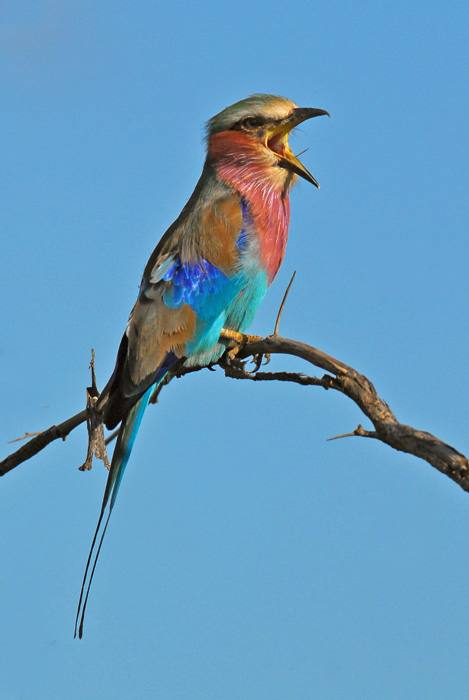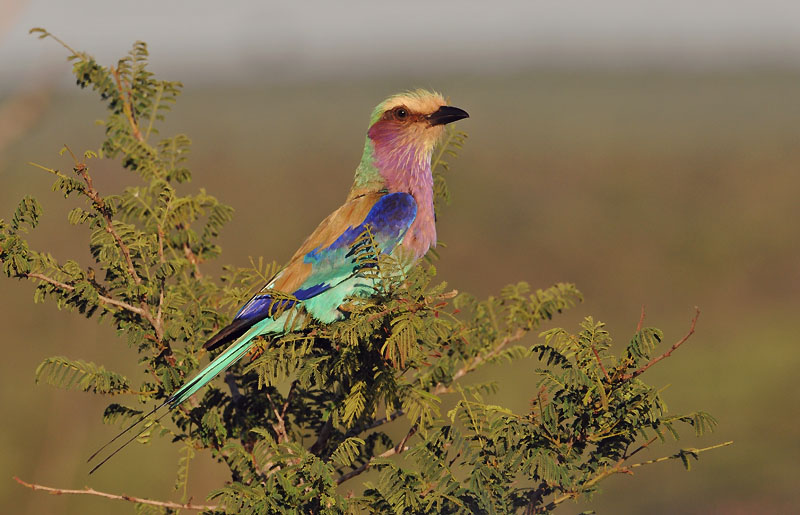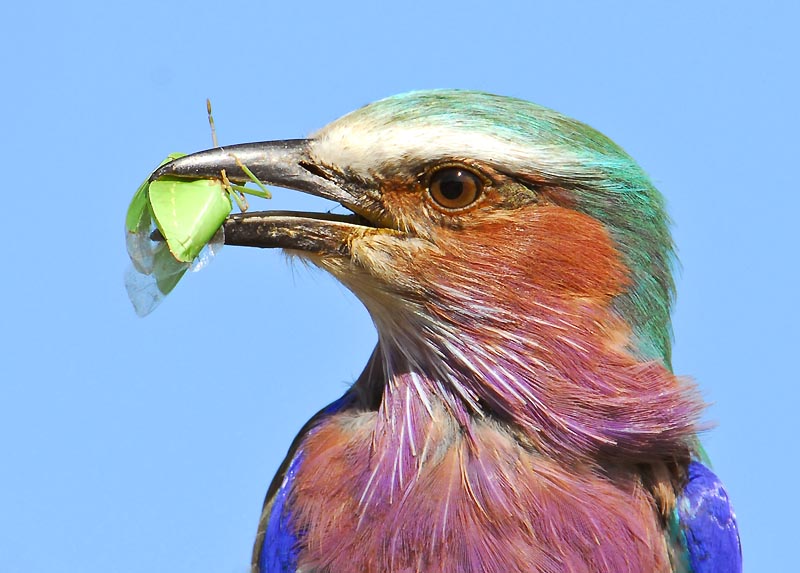
Lilac-breasted Roller
Coracias caudate
Coraciiforme Order - Coraciidae Family
BIOMETRICS:
Length: 36 cm; Weight: 104 g
DESCRIPTION:
Lilac-breasted Roller has large head with washed green crown. Neck is short. The chin is whitish, contrasting with the bright lilac breast. Face is pale pinkish-orange. It has brown back and scapulars, but outer web of flight feathers are violet, as the rump. Primary bases and coverts are pale greenish blue.
The underparts are greenish blue. The narrow tail is medium-sized, but outer feathers are elongated and blackish.
Black bill is strong and hooked tipped. Eyes are brown. Short tail and small feet are greenish yellow.
Both sexes are similar.
Fledglings are greyish brown when fully feathered, at about 20 days of age.


VOICE:
Lilac-breasted Roller’s call is very harsh, a squawk “zaaak”, like a steam train. It utters loud raucous calls while is performing flight displays.
HABITAT:
Lilac-breasted Roller lives in savannas, open woodlands, farmlands, temperate grasslands divided in prairies and steppes, areas with some palm trees, acacia country with spaced trees, and riversides areas.
RANGE:
Lilac-breasted Roller is found throughout eastern and southern Africa.
BEHAVIOUR:
Lilac-breasted Roller performs a wonderful courtship flight, with fast and shallow dive from very high elevation, with rolling or fast rocking motion. It actually breeds “on the wing”.
It is monogamous. It is partly migratory bird, but it is sedentary in some areas. They live in pairs or small groups, but this bird is often seen alone.
Lilac-breasted Roller perches on dead tree to survey the area, searching for prey. It also preys on animals fleeing from bush fires.
To feed, it swoops down from a high perch close to the prey, and as it eats the insect on the ground, or it returns to its perch to batter it before swallowing it whole.
Lilac-breasted Roller is strongly territorial, chasing many species from the nest site, and still after breeding season. It also defends small feeding areas.

FLIGHT:
Lilac-breasted Roller has strong flight, and performs acrobatic flight displays. It is a swift flier.
Its flight display shows the bird flying upwards 10 metres, and then falling with closed wings, gaining in speed by flapping. Flying very fast, it rolls to right and left 4 or 5 times in a couple of seconds, and it sweeps again with closed wings, loosing speed and repeats the roll.

REPRODUCTION:
Lilac-breasted Roller nests in natural cavities in trees, or in termite hills. It may use woodpecker’s and kingfisher’s holes. Nest is unlined.
Female lays 2 to 4 white eggs. Incubation lasts about 22 to 24 days, by both parents. Chicks fledge at about 19 days of age, when they are feathered.
DIET:
Lilac-breasted Roller feeds on insects, such as grasshoppers and beetles, sometimes lizards, crabs and small amphibians. It is also known to take small birds.

PROTECTION / THREATS / STATUS:
Lilac-breasted Roller is common throughout most of its range. Populations tend to increase in summer, but decrease during winter.
Fr: Rollier à longs brins
All : Gabelracke
Esp : Carraca lila
Ital : Ghiandaia marina pettolilla
Nd : Vorkstaartscharrelaar
Photographs by Callie de Wet
GALLERY
Text by Nicole Bouglouan
Sources:
HANDBOOK OF THE BIRDS OF THE WORLD Vol 6 by Josep del Hoyo-Andrew Elliott-Jordi Sargatal - Lynx Edicions, 2001 - ISBN: 848733430X
BIRDS OF AFRICA SOUTH OF THE SAHARA by Ian Sinclair and Peter Ryan - Princeton University Press Princeton and Oxford - ISBN: 0691118159
Wikipedia (Wikipedia, The Free Encyclopedia)